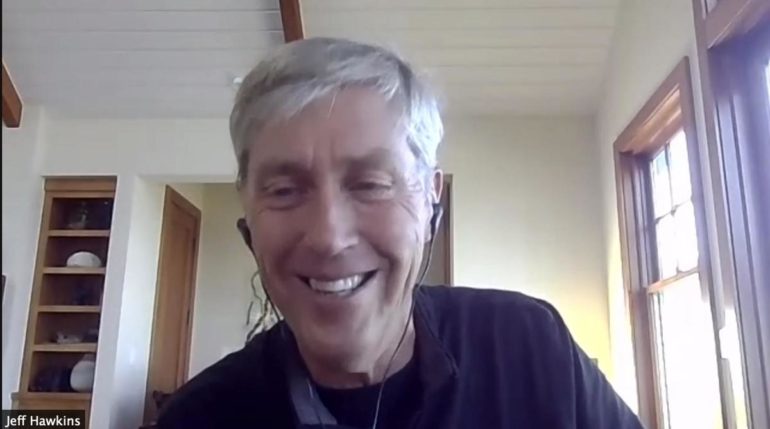“There are a lot of people talking about AI as this huge existential threat, but I don’t see it that way,” says Hawkins. “Gosh, look at what computing has done for us; I think AI will be even bigger.”
We live inside a body ruled by a brute, and the question for humanity may be whether we ever rise up and defy that brute.
Such is, in rough outline, the key question of the human race’s future in A Thousand Brains: A New Theory of Intelligence, the new book about artificial intelligence, and also, surprisingly, about human impulses, by Jeff Hawkins, which went on sale this week.
“What’s the purpose of living, why are we here, what would be a good goal for humanity,” Hawkins mused during a conversation about the book with ZDNet via Zoom last week.
“Intelligence is the thing that defines us, the thing we want to preserve and propagate.”
Life has evolved over millions of years to perpetuate genes via reproduction. Humans, like all life, are “unwitting servants” of genes, gifted with movement and ability only for the purpose of reproduction, writes Hawkins.
In this respect, he subscribes to the theory of the “Selfish Gene,” as put forward by biologist Richard Dawkins. (Dawkins, who wrote the forward to A Thousand Brains, has heaped praise upon the book.)
But recently, “something new has happened,” writes Hawkins in the book.
“Our species became intelligent.”
The story of the entire book is how this mass of cells, the seat of intelligence, is now departing from that enslavement under reproduction to aspire to intelligence beyond mere survival.
Hawkins is in love with the brain, simply put, particularly that part that is most recent, called the neocortex, a napkin-sized layer of cells occupying 70% of the mass of the brain. Many of the most vivid parts of the book are the beautiful descriptions in which Hawkins brings to life the details he has become familiar with regarding this mysterious organ:
Under one square millimeter of neocortex (about 2.5 cubic millimeters), there are roughly one hundred thousand neurons, five hundred million connections between neurons (called synapses), and several kilometers of axons and dendrites. Imagine laying out several kilometers of wire along a road and then trying to squish it into two cubic millimeters, roughly the size of a grain of rice.
The original purpose of the neocortex was to help humans survive better precisely to reproduce, to “avoid predators, find food, and live in varied ecosystems.”
“But our emergent intelligence has had a consequence that is not necessarily in the best interest of genes,” he writes.
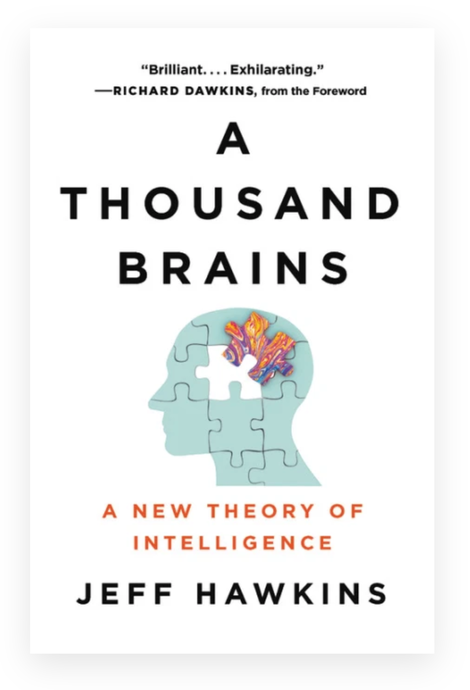

For the first time in the history of life on Earth, we understand what is going on. We have become enlightened. Our neocortex contains a model of evolution and a model of the universe and now it understands the truth underlying our existence. Because of our knowledge and intelligence, we can consider acting in ways that are not in the best interest of genes, such as using birth control or modifying genes that we don’t like.
And yet, the neocortex is still being “jerked around” by the older, more primitive parts of the brain. “The teacher is in the front of the room, saying pay attention to the blackboard, and then someone opens the door to the classroom, and everyone’s head turns!” Hawkins reflected in the Zoom interview.
Humans are biological animals, and the neocortex “is sort of sitting there saying, can I get a little time here,” said Hawkins.
When the neocortex gets a little time, it is the source of insight, and Hawkins is deeply enamored of that function.
“I find it amazing that the only thing in the universe that knows the universe exists is the three-pound mass of cells floating in our heads.”
He would like to preserve it, and one third of the book is spent deliberating whether humans should upload their brains to the computer, or merge with the machine.
Hawkins rejects both prospects as problematic, and probably not worth the effort.
Instead of preserving the individual human, Hawkins suggests an “estate plan for humanity,” as he calls it, to essentially preserve the functions of the neocortex for future intelligent species, as a time capsule of our species’s greatest achievement:
Imagine now that we humans have gone extinct, perhaps due to a natural disaster or to something we did. Other species survive, and in fifty million years one of them becomes intelligent. That species would definitely want to know everything they could about the long-gone human epoch. They would be particularly interested in knowing the extent of our knowledge, and what happened to us.
Romancing the brain is emblematic of Hawkins’s role as an outsider in AI circles and in Silicon Valley. The rebellious element, a rebellious curiosity and a rebellious intellect, defines the book and Hawkins’s own journey.
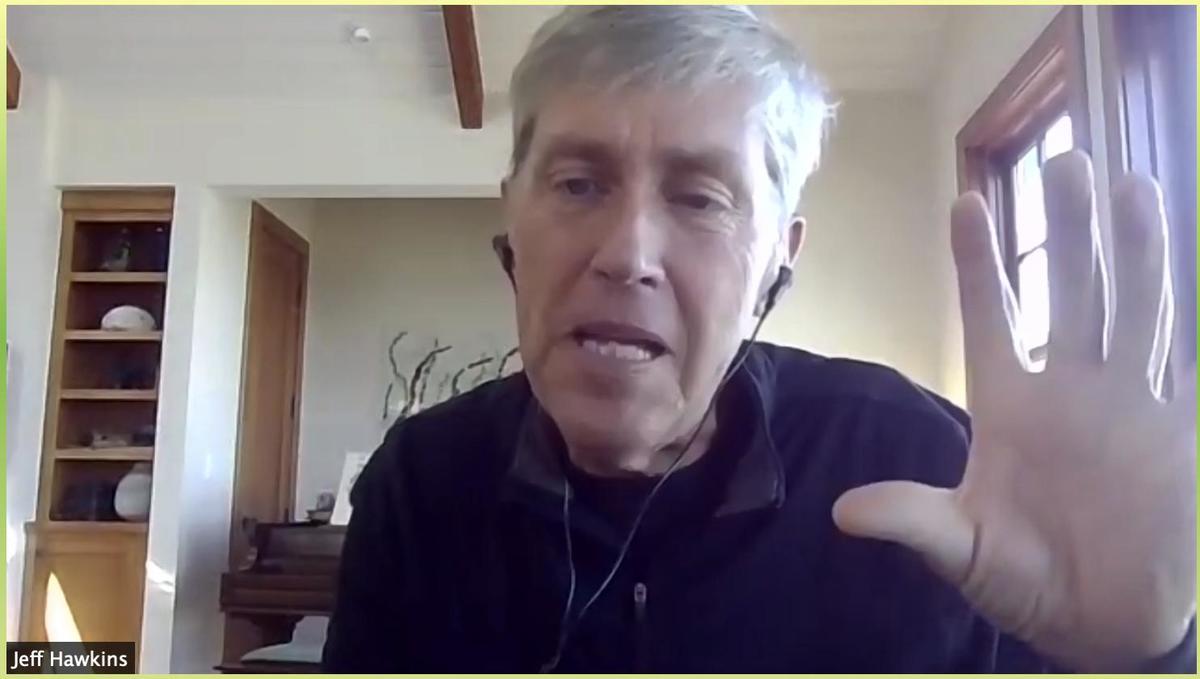

“Thinking is a form of moving” in Hawkins’s theory. We exist in a simulation inside our brains. “When I physically move through world, I’m also moving through the simulated world, there’s a one-to-one correspondence,” he says. “The same way that I can imagine walking through my house, without physically walking through my house, I can imagine walking through mathematics space without physically moving.”
A Thousand Brains is the product of his life’s obsession. He is known to most people as the inventor of the Palm Pilot, but he has been on a quixotic quest for 34 years to form a theory of the brain, first as a grad student at the University of California at Berkeley in 1986. Hawkins soon learned the academic route wasn’t for him. “Trying to develop an overall theory of brain function was considered too ambitious and therefore too risky” for a graduate student, he was advised.
Hawkins turned to business, founding multiple successful startups, including Grid Computing, and then Palm. After wild success with Palm, still enchanted by the brain, he walked away from the business and founded first a research institute, and then a commercial research venture, which he has been running for fifteen years, called Numenta, in the Silicon Valley suburb of Redwood City.
Hawkins’s book is the culmination of those thirty-four years of study, and a singular idea: that intelligence can be understood as a single algorithm operating inside the neocortex.
That idea, put forward by Johns Hopkins neuroscientist Vernon Mountcastle in a 1978 book, The Mindful Brain, has been Hawkins’s obsession. “Mountcastle is proposing that all the things we associate with intelligence, which on the surface appear to be different, are, in reality, manifestations of the same underlying cortical algorithm,” Hawkins writes.
What is that algorithm? The neocortex, Hawkins explains, consists of a sheet of spaghetti-like strands packed tightly together called cortical columns, 150,000 of them in total. Each of those strands contains stacked layers of nerve cells, or neurons. Most of those columns of cells look the same throughout the neocortex. All the different functions such as sight and sound and conceptual reasoning happen within an apparently identical fabric of cells, but how?
The old brain, the one that is common to all living things regardless of intelligence, has what are called place cells and grid cells. They dwell in two small sections of the old brain, the hippocampus and the entorhinal cortex. The two kinds of cells together make a map of where one’s body is in space. A rat uses that map to navigate a maze to cheese, and we humans also use it to navigate our physical world.
The big insight of Hawkins and team in the past decade is that the neocortex is doing the same thing, making maps of things in order to make predictions at any point in time, even about abstract things such as concepts.
If you hear a familiar song, the cortical columns of neurons are predicting the next note. Being aware that one is touching the rim of a coffee cup is a result of having touched it before and storing the physical orientation of one’s hand relative to the rim. Every new experience is building a new map, what’s known as a reference frame, through the release of chemical signals between neurons. “Your five fingertips touching a cup are like five rats exploring a box,” Hawkins writes, drawing the parallel between new brain and old brain.
Most of the time, the brain is quiet because the stimulus of the world around us accords with what’s come before, and a handful of neurons are predicting the next familiar thing. Occasionally, an unlikely thing occurs — an unexpected chip in the rim of the cup — setting off a storm of neuron spikes as the neocortex has to adjust its model of the world.
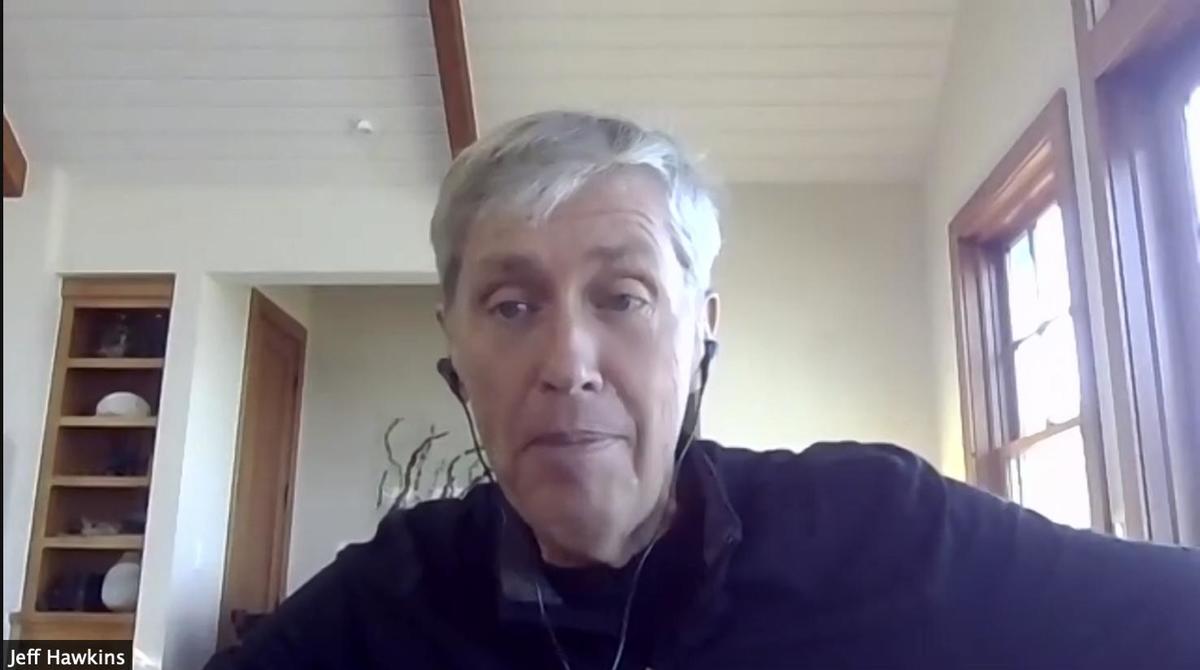

The newer part of our human brain, the neocortex, is still being “jerked around” by the older, more primitive parts of the brain. Humans are biological animals, and the neocortex “is sort of sitting there saying, can I get a little time here.”
Even abstract concepts, argues Hawkins, such as democracy, take the form of predictions as we manipulate the concept in our brain, feeling its contours, like the coffee cup, and forming a map, a frame of reference for the idea.
The “Thousand Brains” are the 150,000 cortical columns that are each making hundreds of maps of everything from how cups look and feel to what we remember about eating ice cream while thinking of a poem.
Hence, Hawkins’s most startling statement: “Thinking is a form of movement.” All the figures of speech, such as turning an idea over in one’s head, or having a thought racing through one’s mind, are in fact quite apt. The neurons in the neocortex light up in sequence as we move through the reference frames that represent an idea.
When we think, it is as if we are the rat in the maze, we have to walk back through the passages to have thoughts at all.
That is the reason, writes Hawkins, that tricks for remembering work, such as the so-called method of loci, the mind palace, where one places a noun in a familiar imagined physical setting.
A Thousand Brains is an important book in this age of industrial AI, so to speak. The entire field has become somewhat narrow, focusing only on the latest deep learning approaches that can be seen to improve scores in benchmark tests by a point or two. It was high time for something to juice up the field with new life, new insights.
“There are really big implications for other fields, especially AI,” Hawkins told ZDNet regarding the theory of thought as movement.
The book at times sounds like a denunciation of the current vogue for deep learning forms of AI, but in conversation, Hawkins is not at all dismissive. “I think current AI systems are pretty damned impressive,” he told ZDNet. “I never would have thought they’d be that good.”
Nevertheless, current machine learning is “not what AI is going to look like” ultimately, he believes. “We’ve got to get it moving in the right direction, and I think ultimately, all of us want to converge on the same spot, there’s just different ways to get there.”
Robotics will be an important part of AI’s advancement, argues Hawkins, because of the need to have sensors move in the world in order to create those frames of reference. Ultimately, AI won’t involve spiking neural net chips, even though they have been a popular part of research into so-called neuromorphic hardware.
Hawkins expects that Numenta will make meaningful contributions to AI, not by tearing down deep learning but by enhancing it.
“We think we have a methodology for really dramatically improving the training paradigms for existing neural networks,” Hawkins told ZDNet. One way is by introducing what’s called “continuous learning” to deep learning. Numenta also hopes to amplify machine learning by implementing reference frames.
“That’s not too far from what Geoff Hinton wants to do with capsules,” said Hawkins, referring to Geoffrey Hinton, the University of Toronto professor of deep learning who also works in Google’s AI group, and his notion of capsule networks. Indeed, a recent paper by Hinton, titled, How to represent part-whole hierarchies in a neural network, reads as if it were inspired by Hawkins’s book.
Hawkins has left that project of extending today’s AI to Numenta’s head of engineering, Subutai Ahmad. “He’s really good at that, so he’s going to take on that challenge,” said Hawkins of Ahmad.
Hawkins is content to stick with his inquiries into the brain. “I have these two great passions, brain theory and AI, but if I could only do one, I would do the brain theory.”
He is currently at work “mopping up the details” of the brain theory. That work consists of a paper Hawkins has been writing for a year now with the working title Understanding space and movement in the brain. The paper will cover numerous details not addressed in the book, including how the brain knows it is moving through space, which basically amounts to how the brain knows that the sensory organs are located in space and time and that they receive stimuli in an ever-changing manner.
“It’ll be a pretty surprising paper from a neuroscience point of view,” Hawkins told ZDNet. One revelation, said Hawkins, is the fact that a part of the brain called the thalamus transforms the signals that the senses pick up from the outside world. When your hand rotates a coffee cup, the thalamus is key to the brain creating reference frames that piece together that movement in space.
The beauty of the brain comes through in Hawkins’s book, but the information has the power to disturb as well. In the thousand brains theory, the human brain is really a simulation of the world. The neocortex doesn’t actually receive images when the eyes see the world. The neocortex has a model of the world and the grid and place cells change their representation of where you are in that simulation.
“When I physically move through the world, I’m also moving through the simulated world, there’s a one-to-one correspondence,” Hawkins explained. “The same way that I can imagine walking through my house, without physically walking through my house, I can imagine walking through mathematics space without physically moving.”
Although Hawkins discusses at length the matter of consciousness, the theory doesn’t resolve a rather prominent question of consciousness, which is why some things in the brain are accessible to consciousness, while most of what the brain does is not accessible.
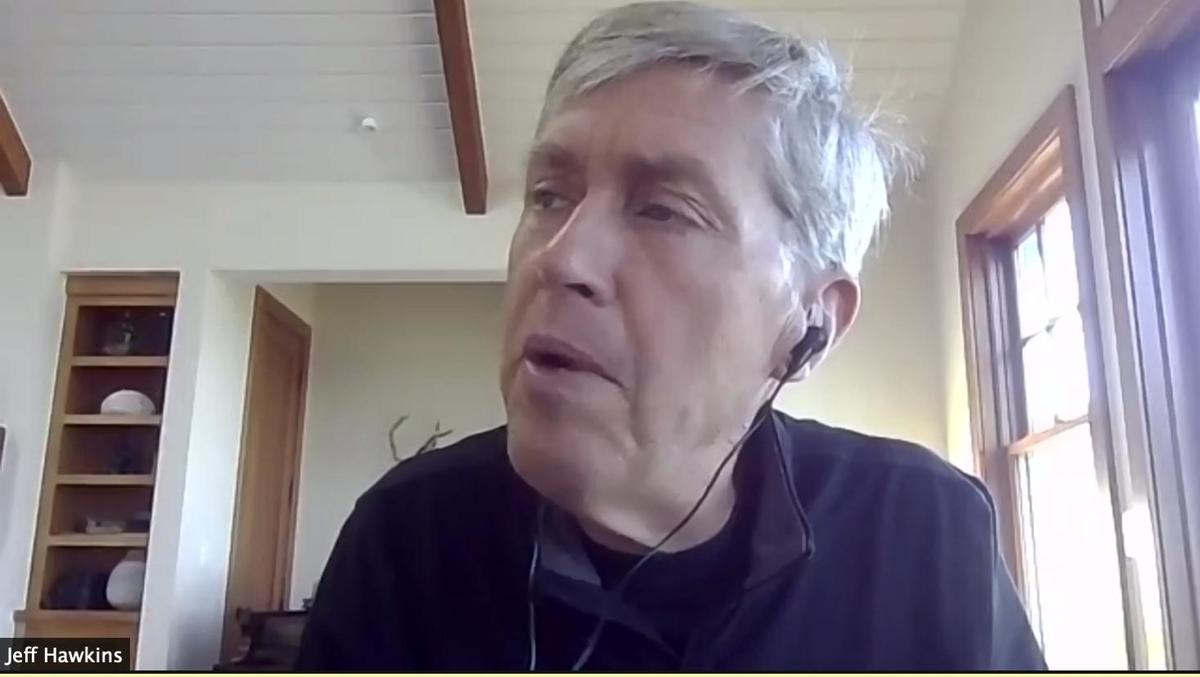

“We think we have a methodology for really dramatically improving the training paradigms for existing neural networks,” Hawkins told ZDNet regarding Numenta’s research on cortical columns and reference frames.
“We are not aware of the vast majority of these predictions” the neocortex makes, writes Hawkins, “unless the input to the brain does not match.
“As I casually reach out to grab my coffee cup, I am not aware that my brain is predicting what each finger will feel.”
Why it should be that nature has chosen to hide so much of the brain from our conscious mind is a matter left for further study.
One implication that Hawkins spends considerable time on is the existential threat to humanity from AI. As a bit of a rebel, Hawkins is not worried the way most people are. He spends the middle third of the book debunking the fear.
The most interesting point that Hawkins brings to the table is that any artificially created intelligence is not suddenly all-knowing. The fact of thought as movement means that any intelligent entity must have experience, it cannot be simply programmed to be superior. It cannot, presumably, know all there is to know in the world without having all of the world’s experience, which is practically impossible.
“Intelligence is not something that can be programmed in software or specified as a list of rules and facts,” he writes. “Although we can make intelligent machines that run a million times faster than a biological brain, they cannot acquire new knowledge a million times faster.”
Not everyone will be convinced by that argument, if only because the prospect of a true thinking machine implies to many people a powerful new weapon for bad human actors to exploit.
For Hawkins, who is enamored of the brain, intelligence must ultimately be the best expression of human potential. Describing his own conscious reflections, he’s apt to relate the magical way in which everything turns out alright.
“The way that I solve problems is that I think about the problem a lot for a long, long time, but I’m never impatient about getting the answer,” Hawkins remarked to ZDNet. “You have to think about it but not worry about it.”
Viewed from that angle, who would not find solace in imagining the mastery of the brain?
“There are a lot of people talking about AI as this huge existential threat, but I don’t see it that way,” he said.
“Gosh, look at what computing has done for us; I think AI will be even bigger.”
